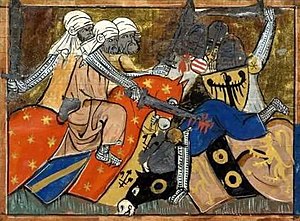Battle of Ager Sanguinis
The Battle of Ager Sanguinis , also known as the Battle of the Blood Field or the Battle of Sarmeda , took place on June 28, 1119 between the Principality of Antioch and the Muslim ruler of Aleppo .
background
Antioch and the other crusader states were constantly at war with the Islamic states in northern Syria and Al Jazeera , especially Aleppo and Mosul . When Radwan of Aleppo died in 1113, a period of peace followed that lasted at least a few years. Roger of Salerno , the regent of Antioch for Bohemond II , did not attack Aleppo despite the unresolved succession to the throne there and the weakening that went with it; and Baldwin II. of Edessa and Pons of Tripoli pursued their own interests and gave up a possible alliance with Roger against Aleppo.
The battle
In 1117 Aleppo came under the rule of Atabeg Ilghazi from the house of the Ortoqids . In 1118, Roger captured Azaz , leaving Aleppo open to attack by Christians. In return, Ilghazi invaded Antioch in 1119. Roger called Baldwin, now King of Jerusalem , and Pons to help, but was of the opinion that he could not wait for their arrival and went with his army against Ilghazi. He was also waiting for support, in his case from Tugtakin of Damascus , but then went against the advancing Christian army and had Roger's camp at Sarmeda Pass rearranged on the night of June 27th. Roger's troops, around 700 knights and 3,000 foot soldiers, were practically completely destroyed on the morning of June 28th. Only a small contingent of less than a hundred mounted men broke out of the grip at the beginning of the battle and were able to flee to Antioch. Roger himself was killed; Most of the Frankish prisoners were also killed after the battle. A small troop under Reinald Mansoer managed to reach Sarmeda in the plain during the battle and initially to escape. A little later he surrendered to the victorious Turkmen military leader and was left alive, but his people were also murdered.
The course of the battle proved that the Syrian Muslims could defeat an army of crusaders without Seljuk help. The place of defeat was called ager sanguinis ( Latin "blood field") by the Franks because of the terrible losses .
consequences
Although Antioch was now essentially defenseless, Ilghazi refrained from attacking the principality. On August 14th he was defeated by the crusaders led by Baldwin II and Pons. Baldwin took over the reign of Antioch, which was severely weakened by this defeat and was the victim of repeated attacks by the Muslims in the following decade. One result of the defeat was that the principality came under the influence of the Byzantine Empire .
Six years later the Crusaders regained some of their influence in Syria through their victory in the Battle of Azaz .
literature
- Steven Runciman : History of the Crusades. dtv , Munich 1995, pp. 455-458 (Orig .: A History of the Crusades. Vol. 2, Cambridge 1952).
- Hans Eberhard Mayer : History of the Crusades. 10., completely revised. u. exp. Ed., Kohlhammer Verlag , Stuttgart 2005, p. 99.
- Thomas Asbridge : The Crusades. 2nd edition, Simon & Schuster, London 2012 (1st edition 2010), p. 164 f.
- Nicholas Morton: The Field of Blood. The Battle for Aleppo and the Remaking of the Medieval Middle East. Hachette, New York 2018.
